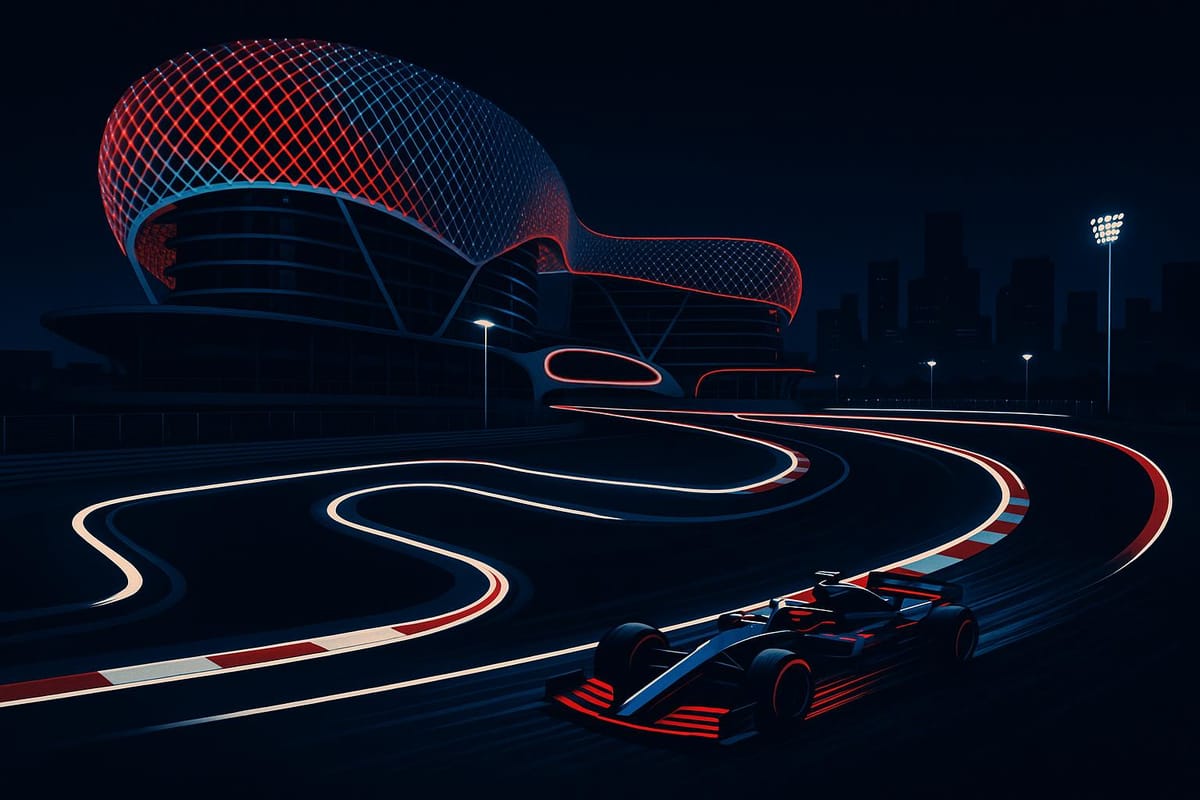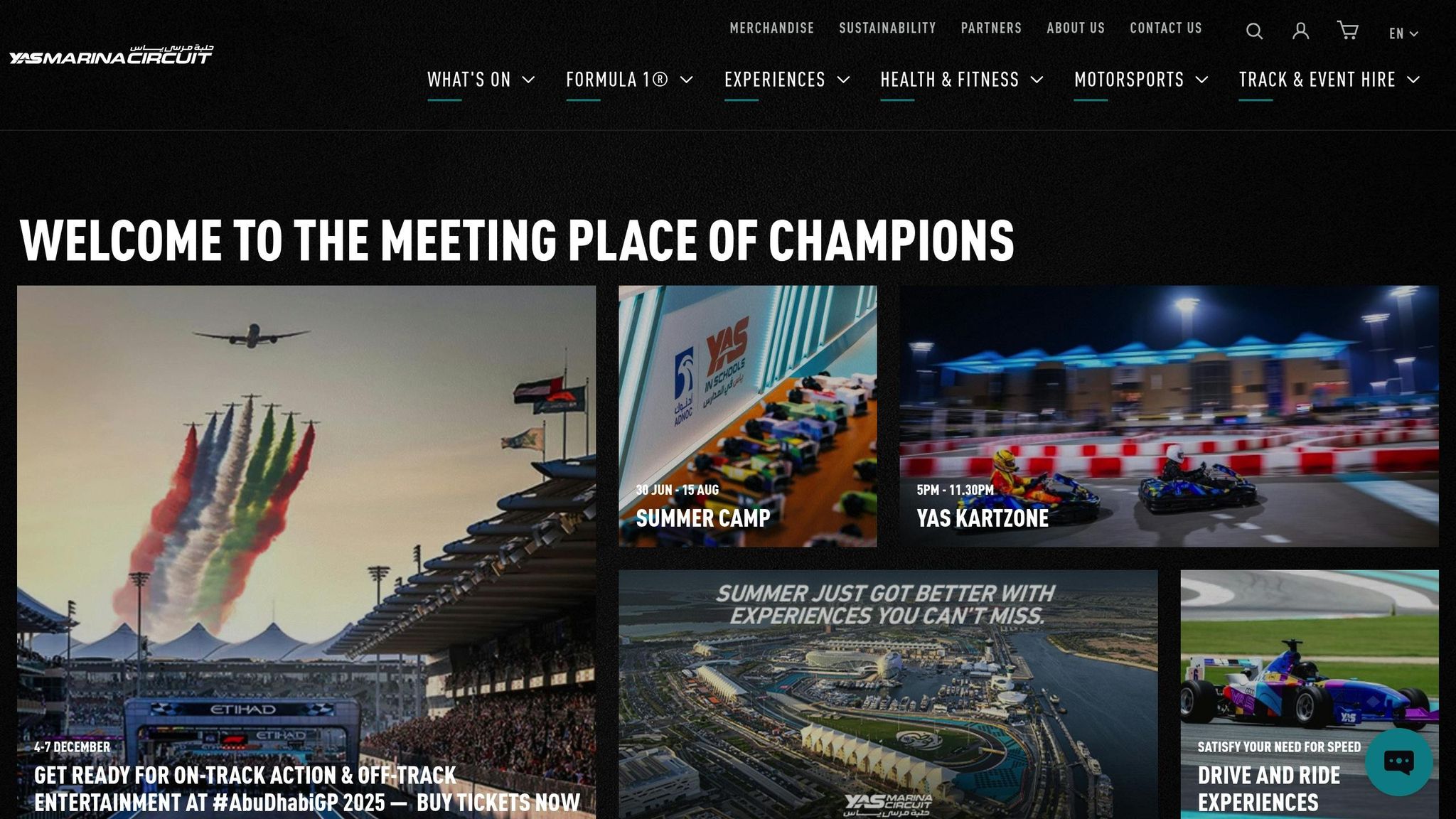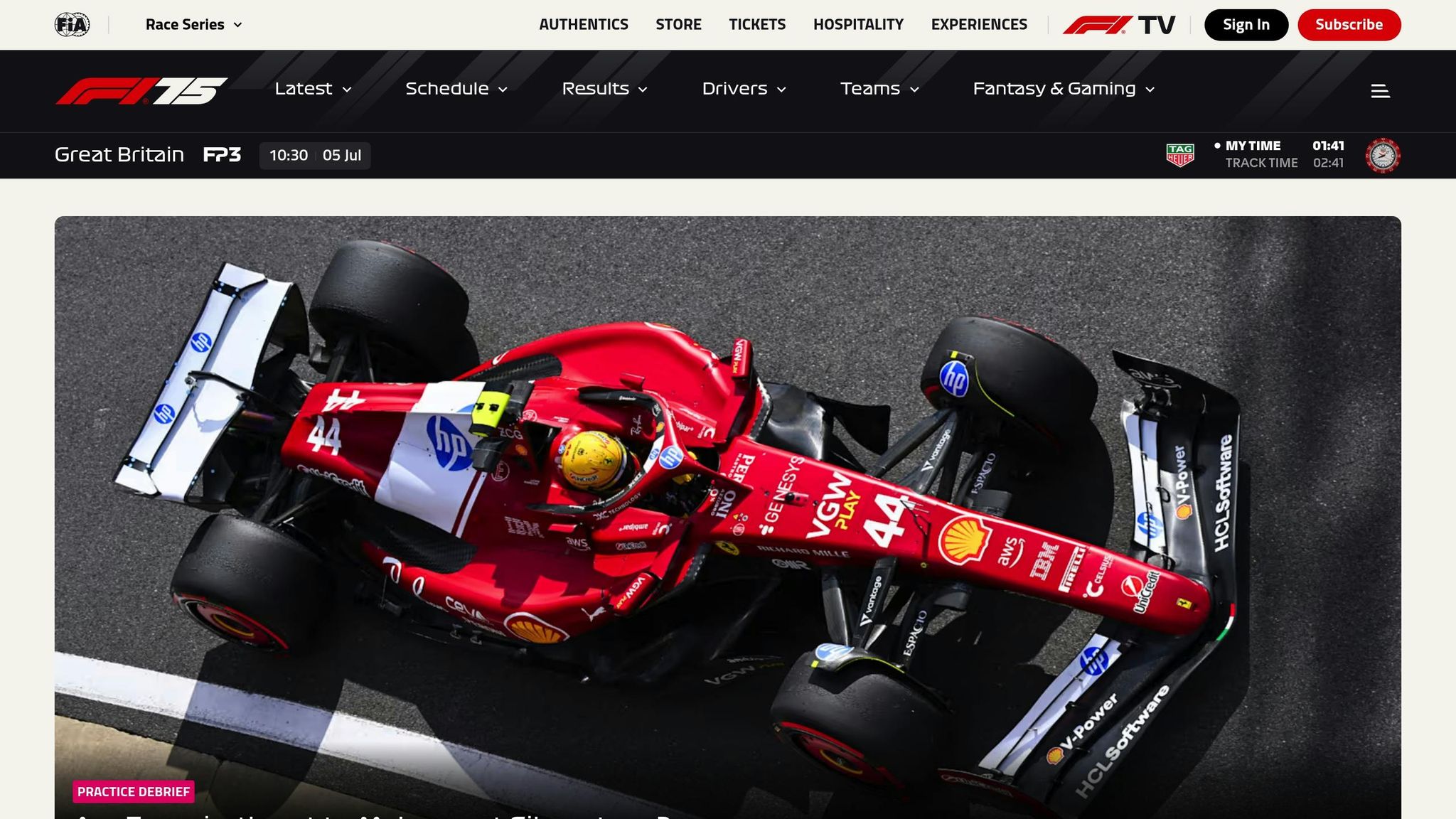Yas Marina Circuit Unpacked: How Abu Dhabi Became F1’s High-Stakes Season Finale
Explore how Yas Marina Circuit transformed Abu Dhabi into a premier destination for Formula One's thrilling season finales since 2009.

The Yas Marina Circuit in Abu Dhabi has become the ultimate stage for Formula One's season finales since 2009. This 3.28-mile track is known for its day-to-night races, cutting-edge design, and iconic moments that have defined F1 history. From its $1.322 billion construction to its dramatic championship deciders, like the Verstappen-Hamilton showdown in 2021, Yas Marina combines technical challenges with breathtaking visuals. Recent upgrades, including a 2021 redesign and sustainability initiatives, ensure it remains a standout venue for fans and drivers alike. With a long-term contract through 2030, Yas Marina continues to set the standard for F1's closing race.
How the Abu Dhabi F1 Track was Built
The Origin and Design of Yas Marina Circuit

Yas Marina Circuit's story begins with Abu Dhabi's bold ambition to establish itself as a global entertainment destination. What was once a desert island became the most expensive Formula One circuit ever built, with an eye-popping construction cost of $1.322 billion. This vision turned into reality at an extraordinary pace, setting a new standard for motorsport venues.
Development Timeline: From Concept to Reality
The journey from blueprint to race-ready circuit was nothing short of remarkable. Construction began in May 2007, with a tight two-year deadline to deliver a world-class Formula One facility. Over 14,000 workers contributed a staggering 35 million man-hours to bring the project to life.
By October 2009, the circuit was certified, and Bruno Senna had the honor of being the first driver to test the track. Just a month later, the venue hosted its first Formula One event, the 2009 Abu Dhabi Grand Prix, following a successful GP2 Asia test event. Observers marveled at the speed and scale of the transformation, as a barren desert island became a cutting-edge racing destination in just over two years.
Hermann Tilke's Visionary Design
The mastermind behind Yas Marina Circuit was Hermann Tilke, a renowned German architect responsible for designing 17 Formula One circuits worldwide. For Tilke, this project was about more than just building a racetrack - it was about creating a venue that harmonized with its surroundings and reflected the spirit of its location.
Tilke's design process began with an in-depth study of the land and its features. As he described:
"We first have to carefully look at the land. Every property has boundaries. We look to the surroundings. We try to get a feel of the region. All of it influences the design. The typography of the area is also very important. The condition and quality of the soil – the surrounding infrastructure – we take those things into consideration."
The result? A circuit with 16 corners and long straights that encourage overtaking through extended braking zones. The 35-foot (10.7 meters) elevation change adds an extra layer of complexity for drivers. One of the most iconic features is the section of the track that runs directly under the W Abu Dhabi Yas Island Hotel, a striking visual that emphasizes the circuit's connection to its environment.
Tilke's son, Carsten, reflected on the challenges of such ambitious projects, highlighting the need for passion:
"The projects we have are difficult and challenging, so if you don't have a passion for it - if you are just doing it because it's work - you won't have the success we have."
A Grand Debut in 2009
When Yas Marina Circuit debuted with the 2009 Abu Dhabi Grand Prix, it marked a turning point for both Formula One and Abu Dhabi. The circuit showcased several standout features, including a permanent lighting system that allowed for a breathtaking transition from daylight to nightfall, the marina that inspired its name, and state-of-the-art facilities.
One review summed up its significance:
"More than just a Formula 1 venue, it serves as the heart of Yas Island, a place designed to fulfill the desires of thrill seekers and racing fans."
The 2009 race demonstrated that Yas Marina Circuit was more than just a racetrack - it was a statement. Its cutting-edge design, dramatic visuals, and challenging layout made it a standout addition to the Formula One calendar. Beyond motorsport, it became a symbol of Abu Dhabi's broader ambitions:
"Yas Marina Circuit may have placed Abu Dhabi firmly on the global motorsport calendar, but its real impact goes beyond racing. It represents a place where high-performance sport, thoughtful design, and elevated experiences come together with intent. This blend is what draws travelers back, not just for the thrill, but for the sense that every detail, on and off the track, has been crafted with care."
The circuit's debut was a resounding success, validating Abu Dhabi's investment and cementing its place as the host of Formula One's iconic season finale.
Technical Features and Race Characteristics
The Yas Marina Circuit stands out as a track that pushes drivers and teams to their limits. Its design, combining a distinctive layout with the challenge of transitioning from dusk to night, offers a unique test for Formula One's best.
Track Layout and Overtaking Zones
With 16 corners and a 0.71-mile (1.14 km) straight - the longest on the track - Yas Marina Circuit presents a demanding course for both drivers and strategists. The 35-foot (10.7-meter) elevation change adds another layer of complexity to the racing experience.
However, the original layout received criticism for failing to deliver thrilling races. Mark Hughes, Managing Director of MRK1, highlighted this issue:
"The one ingredient that let them down was the track."
Several design features contributed to this problem. A chicane preceding the back straight made it tough for drivers to get close enough for overtaking, while off-camber corners in the hotel section caused rear tire temperatures to spike.
In 2021, the circuit underwent a major redesign to address these issues. Changes included a wider hairpin - now 20 meters across - offering multiple racing lines and better overtaking opportunities. Ben Willshire, Managing Director at Driven, noted one key improvement:
"Previously, the braking zone was situated before the chicane, hiding the braking action from spectators, which I think as a spectator is one of the most impressive things you can see a Formula 1 car do."
The redesign also aimed to make the track at least "10 seconds faster" while retaining its technical challenges. Notable updates included a new banked corner at Turn 9 and adjustments around the hotel complex, both of which improved racing lines and overtaking dynamics.
These changes have not only enhanced the spectacle for fans but also set the stage for the unique challenges of racing under changing light conditions.
Dusk-to-Night Racing and Lighting System
Yas Marina Circuit is famous for hosting Formula One's first twilight Grand Prix. The Abu Dhabi Grand Prix begins at dusk and concludes under floodlights, creating a visually stunning race with its own set of challenges.
One of the race's defining features is the dramatic temperature drop, with track temperatures falling from 113°F (45°C) at the start to 86°F (30°C) by the finish. This cooling effect has a direct impact on tire wear and degradation, as Paul Hembery, Director of Pirelli Motorsport, explained:
"The way the temperature drops in Abu Dhabi naturally affects wear and degradation, meaning teams will be able to complete longer stints with the softest compound during the race. This has a significant impact on strategy: it's often possible to try something different in Abu Dhabi compared to other locations, which can pay off at the end of the race."
In addition to tire management, drivers face evolving track conditions. As the sunlight fades, the car's balance shifts, adding another layer of complexity to the race. This interplay of technical and environmental factors makes the Abu Dhabi Grand Prix a standout event in the Formula One calendar.
Yas Marina Circuit as Formula One's Season Finale

Since its debut on the Formula One calendar in 2009, Yas Marina Circuit has become synonymous with the sport's dramatic season finales. Known for hosting some of the most unforgettable moments in modern F1 history, the circuit's design and strategic layout play a pivotal role in shaping team tactics for the final race. These high-stakes events have reshaped how teams and drivers approach the end of the season.
Championship-Deciding Races at Yas Marina
Yas Marina Circuit boasts the record for hosting the most season finales in Formula One history. This tradition began in 2009 and is set to continue through 2030, thanks to a long-term agreement. The circuit's construction reflects Abu Dhabi's significant investment in becoming the ultimate destination for F1's closing race.
Over the years, Yas Marina has been the backdrop for four intense championship-deciding races - in 2010, 2014, 2016, and 2021. Its unique layout and conditions amplify the pressure, often making it the stage for nail-biting finishes. The 2021 finale, for example, highlighted how crucial elements like the Safety Car and tire management can determine the championship's outcome.
Ross Brawn, Formula 1's Managing Director of Motorsports, emphasized the circuit's global appeal:
"As host of the Formula 1 season-finale since 2009, Yas Marina Circuit has established itself as one of the most popular venues for motorsport fans around the world to attend."
How the Circuit Shapes Team and Driver Strategies
Yas Marina Circuit's technical features directly influence team tactics. One standout element is the 1.2 km straight between Turns 5 and 6, which serves as the primary overtaking zone. This stretch highlights the importance of DRS (Drag Reduction System) and slipstreaming, making strategy execution critical.
The race's twilight setting adds another layer of complexity. As track temperatures drop, teams must adapt their tire strategies in real time. Recent modifications to the circuit have further enhanced overtaking opportunities, making races even more dynamic.
Ross Brawn also praised these updates:
"We are fully supportive of the decision to make improvements to the track, with the aim of enhancing the overall motorsport experience across the board, including the Abu Dhabi Grand Prix, for both competitors and spectators."
Yas Marina vs Other Season Finale Circuits
Yas Marina Circuit isn't just about the racing - it also offers an unmatched experience off the track. Abu Dhabi’s luxurious hotels, theme parks, and world-class amenities create a compelling destination for teams, drivers, and fans alike. This combination of high-stakes racing and premium leisure has solidified its place as a favorite on the F1 calendar.
Saif Al Noaimi, Acting CEO of Abu Dhabi Motorsports Management, highlighted the venue's commitment to growth:
"As a venue, we are continually identifying ways in which we can evolve, keep our product offerings fresh and retain the support of our loyal fanbase."
Historic Races and Key Moments
Yas Marina Circuit, with its cutting-edge design and strategic layout, has been the stage for some of Formula One's most unforgettable moments. Since becoming the season-ending venue in 2009, it has consistently delivered drama, excitement, and performances that have shaped the sport's history and captivated fans worldwide.
Championship Wins and Standout Driver Performances
The circuit has witnessed some of the most pivotal championship battles in Formula One history. In 2010, Sebastian Vettel seized his first title after starting third on the grid, taking advantage of mistakes by his rivals. At just 23 years old, he became the youngest champion in the sport’s history. Another unforgettable moment came in 2016 when Nico Rosberg claimed his sole world title. Despite finishing second to teammate Lewis Hamilton, Rosberg’s calculated drive under immense pressure secured his place in F1 history.
The 2021 finale remains one of the most debated races ever. Max Verstappen overtook Hamilton on the very last lap, following a controversial safety car decision, to claim his first championship. Meanwhile, Lewis Hamilton’s dominant performance in 2019, where he set a lap record of 1:39.283, showcased his unparalleled ability to adapt to the circuit’s technical challenges and unique twilight conditions.
Close Finishes and Controversial Decisions
Yas Marina has also been the backdrop for razor-thin finishes and decisions that sparked heated debates. The 2021 Abu Dhabi Grand Prix is etched in memory as one of the most contentious races in modern F1. A controversial safety car procedure allowed only specific lapped cars to unlap themselves, giving Verstappen - on fresher tires - a chance to overtake Hamilton on the final lap. This incident led to sweeping changes in race management protocols.
Another dramatic moment unfolded during the 2016 finale. In a high-stakes strategic move, Hamilton deliberately slowed the pace in the closing laps in an attempt to back Rosberg into rival drivers, hoping to jeopardize his teammate’s championship chances. The move led to intense team radio exchanges, highlighting the psychological warfare that often accompanies title-deciding races.
Yas Marina Circuit's Impact on Formula One
Yas Marina has transformed the way Formula One approaches season finales. Its world-class facilities, unique twilight racing conditions, and ability to deliver high-stakes drama have set a benchmark for championship-deciding events. Beyond the races themselves, the venue has influenced how teams strategize for season finales and how fans anticipate the culmination of a year-long championship battle.
The global spotlight on these dramatic finales has also boosted Formula One's visibility, particularly in emerging markets. Abu Dhabi’s substantial investments in motorsport infrastructure have not only enhanced the fan experience but also inspired other venues to elevate their standards in pursuit of hosting rights.
| Year | Champion | Impact on F1 |
|---|---|---|
| 2010 | Sebastian Vettel | Cemented Yas Marina as a premier championship venue |
| 2016 | Nico Rosberg | Showcased the mental pressures of title-deciding races |
| 2021 | Max Verstappen | Triggered major changes in race management practices |
The fallout from the 2021 finale, in particular, underscored the importance of clear and consistent race regulations. Yas Marina’s success has also encouraged Formula One to craft finales that blend thrilling racing with top-tier entertainment - offering luxury, spectacle, and a memorable experience for fans and stakeholders alike.
Yas Marina Circuit's Future in Formula One
Yas Marina Circuit is set to remain the home of Formula One's season finale beyond 2025, with plans for continuous upgrades and environmental advancements. This reflects Abu Dhabi's enduring dedication to Formula One and the sport's broader shift toward sustainability. Recent green initiatives and strategic investments highlight this commitment.
Circuit Upgrades and F1's Environmental Goals
Yas Marina Circuit has taken major strides in aligning with Formula One's sustainability objectives. In August 2023, it teamed up with Emerge to install over 62,000 square feet of solar panels, producing about 1,507 kWp of clean energy. This project cuts CO₂ emissions by more than 1,000 tons annually - the equivalent of powering 200 homes.
Another significant improvement came through a revamped lighting system in collaboration with Farnek. By replacing 3,914 fixtures with energy-efficient LEDs, the circuit achieved a 32% reduction in annual energy use, a 31% cut in embodied carbon, and a 29% drop in diesel consumption. These LED fixtures also boast an extended lifespan of 120,000 hours - 24 times longer than the previous system.
"We are constantly working on improving our environmental management efforts across the whole Yas Marina Circuit community, and we are proud that this weekend will be our most sustainable Abu Dhabi Grand Prix ever. This represents a key marker in our progress and ever-evolving journey to net-zero operations – driven by innovative low-carbon solutions." - Saif Rashid Al Noaimi, CEO, Ethara
In May 2024, the circuit unveiled a 1-megawatt solar car park, which now supplies 30% of its annual energy needs. This installation offsets 900 tons of CO₂ emissions each year while providing shaded parking for race attendees.
Yas Marina has also joined the Net Zero Initiative under the United Nations Sports for Climate Action framework, aiming to achieve Net Zero Greenhouse Gas Emissions certification by 2040. The circuit has set an interim goal to cut emissions by 50% by 2030 and is already making progress - emissions during the 2023 Abu Dhabi Grand Prix were 40% lower compared to 2022. The circuit’s commitment to sustainability has earned it FIA 3-Star Certification for environmental performance, and through its partnership with DGrade, it upcycles 18,000 plastic bottles annually. These efforts not only align with F1's sustainability strategy but also position Yas Marina as a model for future motorsport venues.
Abu Dhabi's Growing Motorsport Influence
Abu Dhabi's investments in motorsport extend beyond sustainability, reinforcing its status as a global player in the industry. In December 2021, Abu Dhabi Motorsports Management secured an extension to host the Formula 1 Etihad Airways Abu Dhabi Grand Prix until 2030. This ensures Yas Marina Circuit will continue as the sport's season-ending venue for years to come. Hosting rights come at a cost - the UAE pays $55 million annually - but the returns are substantial. The circuit attracts 125,000 spectators each year, and the 2021 Abu Dhabi Grand Prix alone drew an impressive global audience of 108.7 million viewers.
Formula One leadership acknowledges Abu Dhabi's importance in the sport's global growth, especially as the Middle East becomes a key market for engaging younger fans. Stefano Domenicali, President and CEO of Formula 1, highlighted this during the announcement of the contract extension:
"We are delighted to confirm that we will be racing in Abu Dhabi until 2030 under this new agreement. We are hugely looking forward to the season finale this weekend when more Formula 1 history will be made. The promoter, ADMM, always creates an incredible show for the final race of every F1 season and combined with the changes made to improve the racing on the Yas Marina Circuit we are excited for many years of racing in Abu Dhabi that is ahead of us."
Yas Marina Circuit continues to innovate beyond race weekends. The venue frequently upgrades its facilities, including advanced timing systems, improved hospitality areas, and enhanced spectator experiences, ensuring it remains a standout destination as Formula One evaluates future calendar additions. Additionally, strategic collaborations underscore its leadership in sustainable event management. In December 2024, Ethara partnered with Aggreko Middle East to optimize emissions through biodiesel use, energy load management, and solar-powered battery storage during race events. These efforts showcase Yas Marina's role as a trailblazer in sustainability practices that could influence Formula One globally.
Conclusion: Yas Marina Circuit's Formula One Legacy
Since its debut in 2009, Yas Marina Circuit has transformed Formula One season finales into unforgettable, high-stakes showdowns. Spanning 3.28 miles (5.28 km) and crafted by Hermann Tilke, the track has become a stage for some of the sport's most iconic moments.
The circuit's cutting-edge features have reshaped the standards of Formula One. With its permanent lighting system and advanced infrastructure, Yas Marina has not only raised the bar for modern track design but also created a thrilling environment that challenges drivers and captivates fans. These advancements have played a central role in delivering racing moments that are etched into the annals of F1 history.
Memorable events include Sebastian Vettel clinching his first world title in 2010, Nico Rosberg's championship triumph in 2016, and the jaw-dropping 2021 finale where Max Verstappen secured the title in a dramatic last-lap duel with Lewis Hamilton. These defining moments have cemented Yas Marina as a venue where legends are made.
Off the track, Yas Marina has revolutionized the Formula One experience. Seamlessly blending with Abu Dhabi's tourism vision, the circuit offers luxury amenities and state-of-the-art facilities that have redefined what a Grand Prix weekend can deliver. Attracting around 125,000 fans annually and captivating global audiences of over 100 million, Yas Marina has become a symbol of excellence in motorsport entertainment.
Looking ahead, the circuit is embracing a sustainable future through ongoing upgrades and environmental initiatives. As Formula One adopts new technologies, Yas Marina's forward-thinking design and commitment to innovation ensure it remains a leader in motorsport infrastructure and fan engagement.
Yas Marina Circuit stands as a purpose-built masterpiece, capturing the essence of F1 drama while continuously pushing the boundaries of racing and entertainment. Its legacy endures, setting benchmarks both on and off the track.
FAQs
What updates were made to the Yas Marina Circuit in 2021 to improve overtaking and make races more exciting?
In 2021, the Yas Marina Circuit saw some major updates aimed at shaking up the racing action. To encourage more overtaking and improve the overall flow of the race, the track underwent a few key changes. These included removing two sets of slow corners, widening Turn 7, and redesigning Turns 17 and 20 to create faster, smoother sections. The idea was simple: make the track more engaging for drivers and fans alike by fostering tighter battles and more overtaking opportunities.
Since these changes, the circuit has gained a reputation as a more electrifying venue, particularly for championship-deciding races, solidifying its place as a dramatic finale on the Formula 1 calendar.
How does the day-to-night transition at the Abu Dhabi Grand Prix impact team strategies and tire management?
The shift from day to night at the Abu Dhabi Grand Prix adds a fascinating layer of complexity to race strategies and tire management. As evening sets in and the track temperature drops, tire wear slows, giving teams the opportunity to extend stints and maintain stronger grip. On the flip side, the heat of the daytime accelerates tire degradation, often forcing earlier pit stops and careful tire choices.
To navigate these shifting conditions, teams must meticulously plan their pit stops and tire strategies. Harder tires, known for their durability in high temperatures, are a popular choice during the hotter parts of the race. However, they can struggle to deliver optimal grip as the track cools at night. This constant balancing act makes the Abu Dhabi Grand Prix a true test of strategy, where even the smallest adjustments can make a big difference in the final results.
How has the Yas Marina Circuit cemented Abu Dhabi's status as a premier motorsport destination, and what sets it apart from other F1 season finale venues?
Yas Marina Circuit: A Global Motorsport Icon
The Yas Marina Circuit has firmly established Abu Dhabi as a key player on the global motorsport stage. With its sleek design, world-class facilities, and breathtaking waterfront setting, it has become a hallmark of Formula 1's high-stakes season finales. Over the years, the circuit has witnessed multiple championship-deciding races, enhancing its reputation and allure.
What truly sets Yas Marina apart is its ability to combine cutting-edge technology with unforgettable spectacle. From its state-of-the-art infrastructure to the electrifying atmosphere of night races, every detail is designed to deliver a thrilling experience for both drivers and fans. Unlike other circuits such as Bahrain or Qatar, Yas Marina has consistently held the honor of hosting the season's final showdown, solidifying its status as a legendary destination in the world of Formula 1.
Related posts
- Albert Park Uncovered: The History, Evolution, and Challenges of the Australian Grand Prix Circuit
- Bahrain International Circuit: From Desert Debut to DRS Battles Under the Lights
- Jeddah Corniche Circuit: The High-Speed Street Track Redefining Night Racing in Saudi Arabia
- Marina Bay Circuit: The Origins and Evolution of Singapore’s Iconic Night Grand Prix




